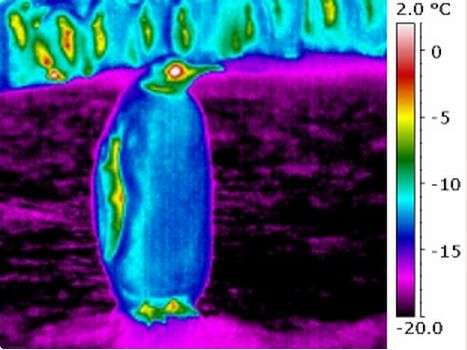March 7, 2013 report
Researchers find emperor penguins outer feathers colder than surrounding air

(Phys.org) —A research team made up of members from France and the U.K. has discovered that when in cold temperatures, the outer feathers of the emperor penguin are actually colder than the surrounding air. As the team describes in their paper published in the journal Biology Letters, they discovered the unusual thermal properties of the penguin's feathers while studying the birds in their natural environment using infrared imaging.
To gain a better understanding of how emperor penguins are able to withstand extremely low temperatures for months at a time, the research team ventured down to Terre Adélie, Antarctica, during June 2008. There they took hundreds of infrared thermal images of penguins that had moved slightly apart from the others—that allowed for full body images to be taken and minimized the collective warming that occurs as the animals huddle together.
Upon examining the multicolored images, the researchers were surprised to discover that the outer feathers that cover most of the penguins' body, were actually four to six degrees Celsius colder than the surrounding air. With most other birds, and animals, the air around their bodies is warmer. The researchers explain that the apparent anomaly appears to be due to what they describe as "extreme radiative cooling." It's similar to frost building up on surfaces on a cold morning. It happens with the penguins when their protective coat radiates more heat into the colder sky than is absorbed from the surrounding air—this causes the temperature at the surface of their feathers to fall below that of the surrounding air. The end result, the researchers report, is that the penguins are able to draw very tiny amounts of heat back to their feathers from the surrounding air, helping them to conserve energy. It's not much, the researchers conclude, but when trying to survive in a very cold climate for very long periods of time, every little bit helps.
In looking at the thermal images, the researchers also noted that the birds do have a few "hot" spots—eyes, beak and feet, where heat escapes. The eyes in particular, bright red in the photos, suggest that penguins must take care to protect such vulnerable areas from bitter wind. They note that earlier studies have found that the more at-risk areas of the penguins' body have special blood vessels that help to conserve heat.
More information: Emperor penguin body surfaces cool below air temperature, Published online Biology Letters, March 6, 2013. doi: 10.1098/rsbl.2012.1192
Abstract
Emperor penguins Aptenodytes forsteri are able to survive the harsh Antarctic climate because of specialized anatomical, physiological and behavioural adaptations for minimizing heat loss. Heat transfer theory predicts that metabolic heat loss in this species will mostly depend on radiative and convective cooling. To examine this, thermal imaging of emperor penguins was undertaken at the breeding colony of Pointe Géologie in Terre Adélie (66°40′ S 140° 01′ E), Antarctica in June 2008. During clear sky conditions, most outer surfaces of the body were colder than surrounding sub-zero air owing to radiative cooling. In these conditions, the feather surface will paradoxically gain heat by convection from surrounding air. However, owing to the low thermal conductivity of plumage any heat transfer to the skin surface will be negligible. Future thermal imaging studies are likely to yield further insights into the adaptations of this species to the Antarctic climate.
Journal information: Biology Letters
© 2013 Phys.org


















